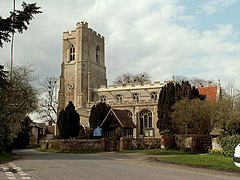Great Waldingfield
| Great Waldingfield | |
|---|---|
 St. Lawrence church, Great Waldingfield |
|
| Great Waldingfield shown within Suffolk | |
| Population | 1,431 (2011) |
| OS grid reference | TL9043 |
| District | |
| Shire county | |
| Region | |
| Country | England |
| Sovereign state | United Kingdom |
| Post town | SUDBURY |
| Postcode district | CO10 |
| Dialling code | 01787 |
| Police | Suffolk |
| Fire | Suffolk |
| Ambulance | East of England |
| EU Parliament | East of England |
| UK Parliament | |
Great Waldingfield is a village and civil parish in the Babergh district of Suffolk, England about two miles (3 km) north-east of Sudbury and two miles (3 km) south-west of its sister village, Little Waldingfield. The village is split into two separate parts; the older and smaller part around the St. Lawrence Church, and the newer and larger section along the B1115 road between Sudbury and Hadleigh. Most of the houses in the newer section were built after World War II, including much council housing. The population is estimated to be 1,460, reducing to 1,431 at the 2011 Census. The parish also includes the hamlet of Upsher Green.
The village hall was the normal location of the halfway feeding station on the Dunwich Dynamo overnight bicycle ride until 2010, whilst an episode of Lovejoy ("Fruit of the Dessert") was filmed in the village.
The discovery of a number of artefacts suggests that the village existed during the Bronze Age and the Roman occupation of Britain, but the first record of the village's existence is from the Domesday Book of 1086, in which the village was listed as Walingafella Magna with three Saxon manors and an area of around 3,000 acres (12 km²).
Located on the major thoroughfare between the wool town of Lavenham and Sudbury, the village was well placed to benefit from the trade boom in the late Middle Ages.
An outbreak of Bubonic plague in 1626 reduced the population by at least 10%, going from 513 in 1611 to 459 in 1631.
In 1648, during the siege of Colchester (part of the English Civil War) Cromwell's Ironsides were billeted in the village, an area which became Garrison Lane. Soldiers were stationed in the village after the war before being demobilised.
...
Wikipedia

